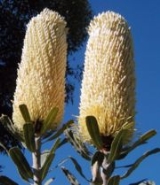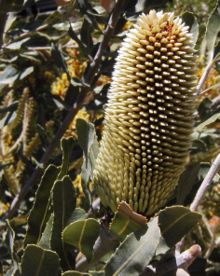
Banksia sceptrum
Encyclopedia

Western Australia
Western Australia is a state of Australia, occupying the entire western third of the Australian continent. It is bounded by the Indian Ocean to the north and west, the Great Australian Bight and Indian Ocean to the south, the Northern Territory to the north-east and South Australia to the south-east...
near the central west coast from Geraldton
Geraldton, Western Australia
Geraldton is a city and port in Western Australia located north of Perth in the Mid West region. Geraldton has an estimated population at June 2010 of 36,958...
north through Kalbarri
Kalbarri, Western Australia
Kalbarri is a coastal town in the Mid West region located 592 km north of Perth, Western Australia. The town is found at the mouth of the Murchison River and has an elevation of...
to Hamelin Pool. It extends inland almost to Mullewa
Mullewa, Western Australia
- External links :* *...
.
In nature, it grows in deep yellow or pale red sand in tall shrubland, commonly on dunes, being found as a shrub to 6 metres (20 ft) high, though often smaller in exposed areas. It is killed by fire and regenerates by seed
Seed
A seed is a small embryonic plant enclosed in a covering called the seed coat, usually with some stored food. It is the product of the ripened ovule of gymnosperm and angiosperm plants which occurs after fertilization and some growth within the mother plant...
. Follicles open with fire. Banksia sceptrum is one of the most striking yellow-flowered banksia
Banksia
Banksia is a genus of around 170 species in the plant family Proteaceae. These Australian wildflowers and popular garden plants are easily recognised by their characteristic flower spikes and fruiting "cones" and heads. When it comes to size, banksias range from prostrate woody shrubs to trees up...
s of all. Its tall bright yellow spikes are terminal and well displayed. Flowering is in summer, mainly December and January, though occasional flowers are rarely seen at other times.
Ecology
An assessment of the potential impact of climate changeClimate change
Climate change is a significant and lasting change in the statistical distribution of weather patterns over periods ranging from decades to millions of years. It may be a change in average weather conditions or the distribution of events around that average...
on this species found that its range is unlikely to contract and may actually grow, depending on how effectively it migrates into newly habitable areas.
Cultivation
It is principally used in the cut flower industry, with the immature spikes being commonly sold in florists around Australia.It is occasionally grown in gardens, but requires a Mediterranean
Mediterranean climate
A Mediterranean climate is the climate typical of most of the lands in the Mediterranean Basin, and is a particular variety of subtropical climate...
(dry summer climate) and good drainage as it is sensitive to dieback
Phytophthora cinnamomi
Phytophthora cinnamomi is a soil-borne water mould that produces an infection which causes a condition in plants called root rot or dieback. The plant pathogen is one of the world's most invasive species and is present in over 70 countries from around the world.- Life cycle and effects on plants :P...
.
Seeds do not require any treatment, and take 26 to 47 days to germinate.

